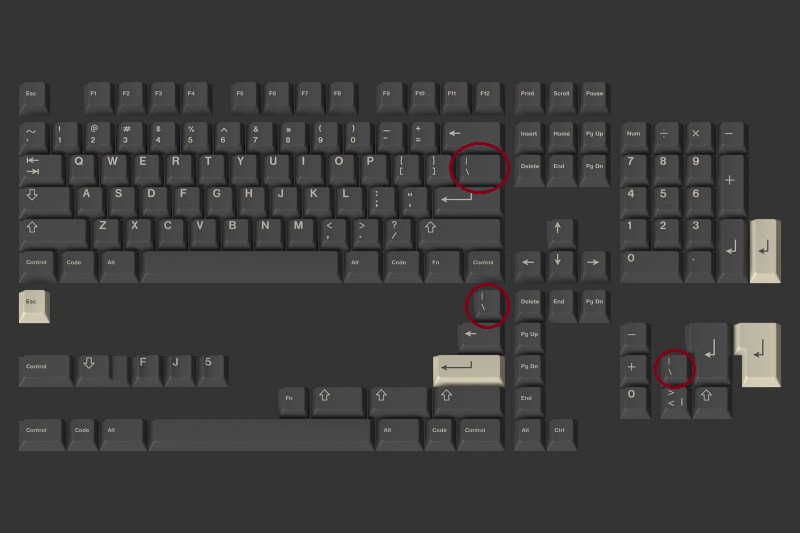
GMK Nines: three keycaps on as many rows.
Why do keycap sets have so many copies of the backslash‑pipe (\|) key?
Because different keyboard layouts place the backslash‑pipe key in differing locations, and keycap sets provide multiple copies of it to ensure compatibility with them (as well as one other reason).
Let’s take a look at some keycap sets and count how many times does the backslash‑pipe keycap show up:

GMK Nines: three keycaps on as many rows.
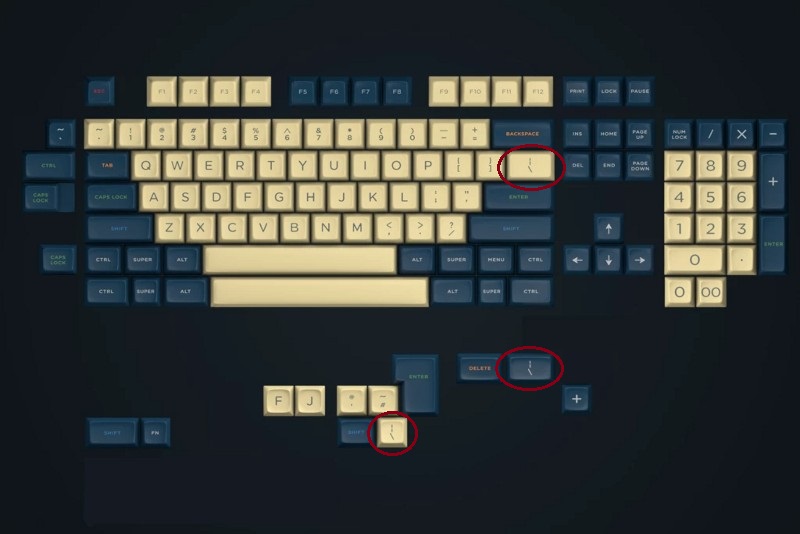
DSA Penumbra: three keycaps on two rows.
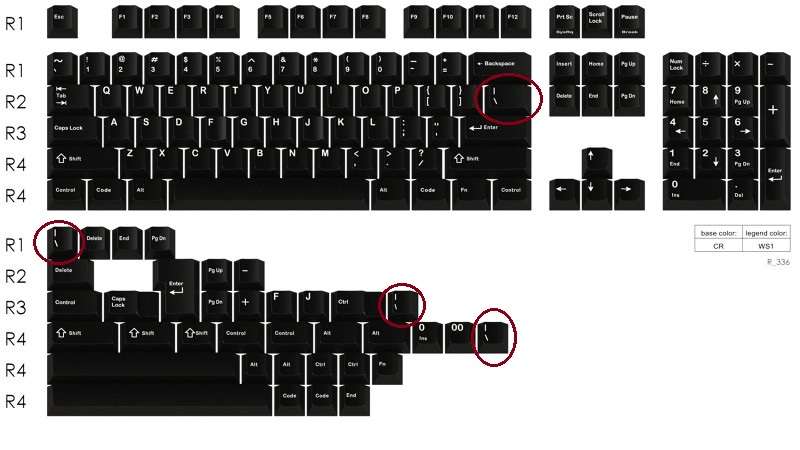
GMK White on Black: four keycaps on as many rows.
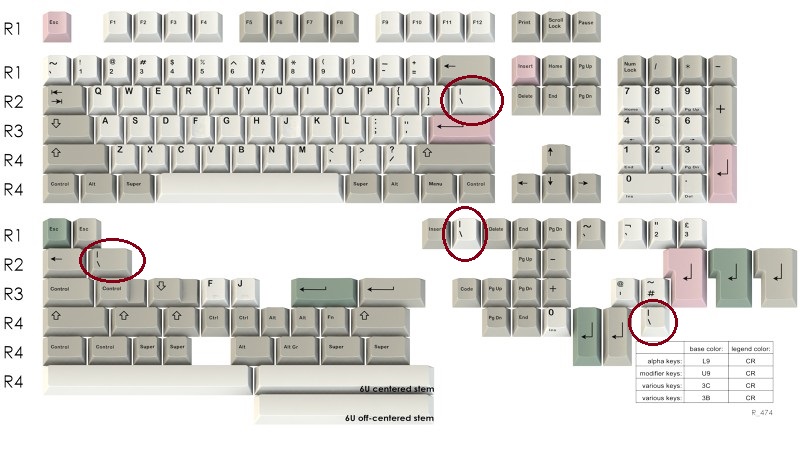
GMK 9009 R2: four keycaps on three rows.
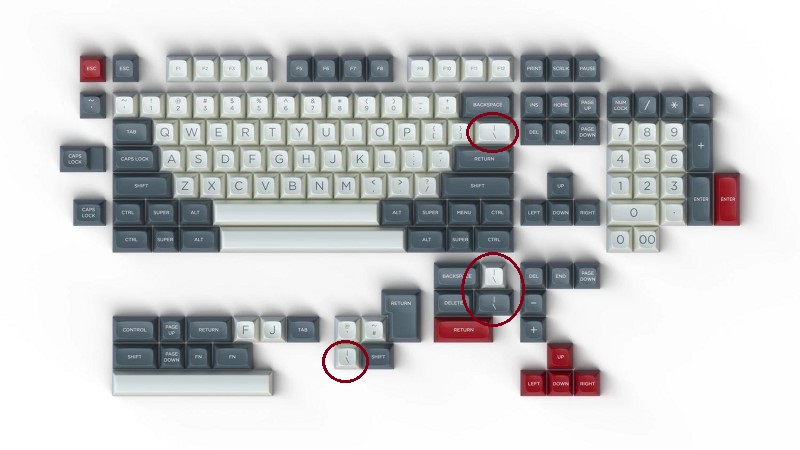
SA Honeywell: four keycaps on three rows.
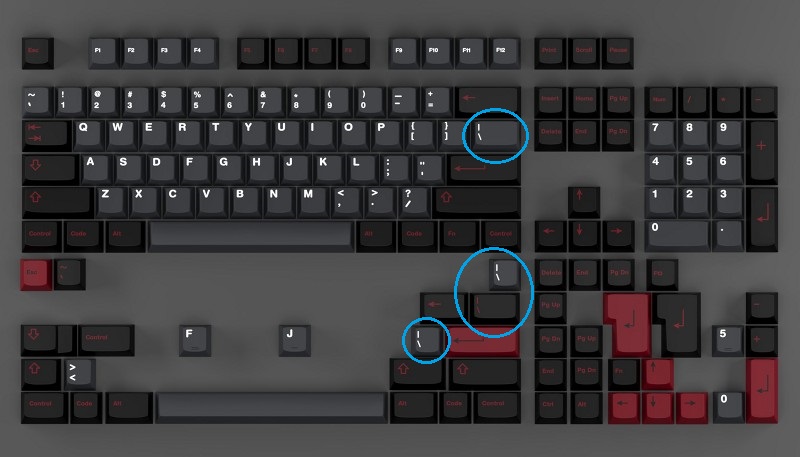
GMK Evil Dolch: four keycaps on three rows (one
of which differs from the two previous sets).
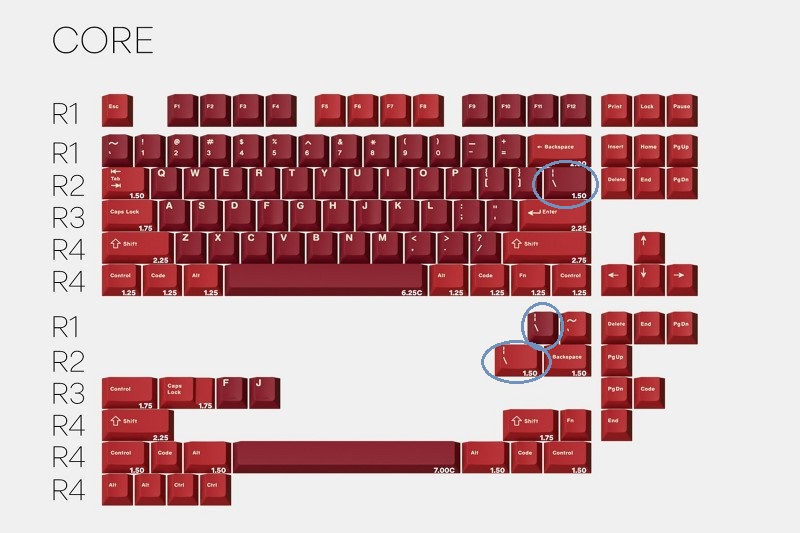
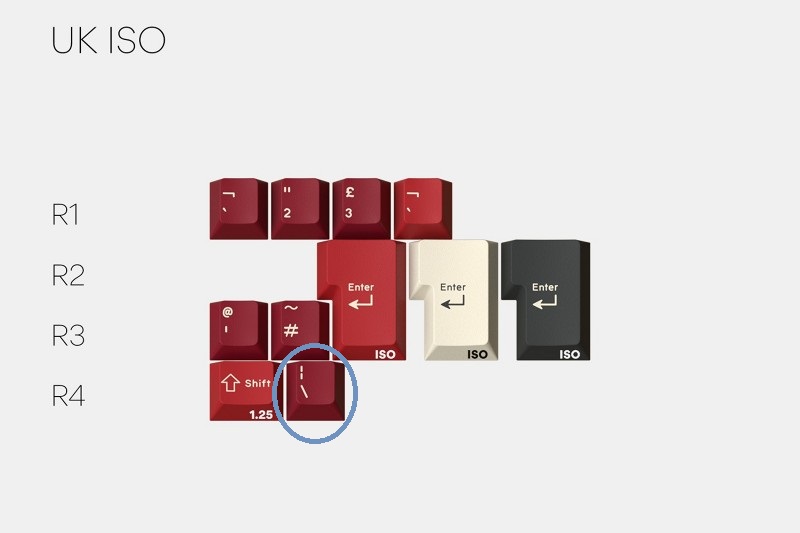
GMK Jamón: three keycaps on two rows in the base kit, and
one more on another row in an extra kit.
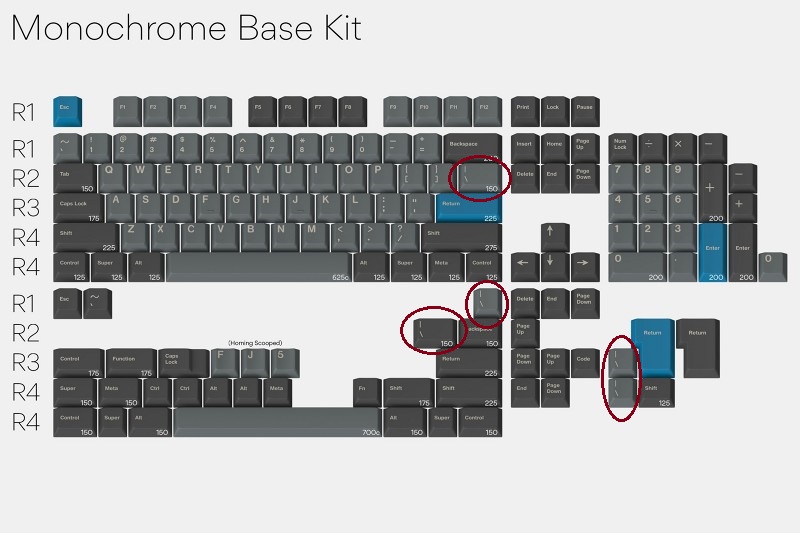
GMK Oblivion: five keycaps on four rows.
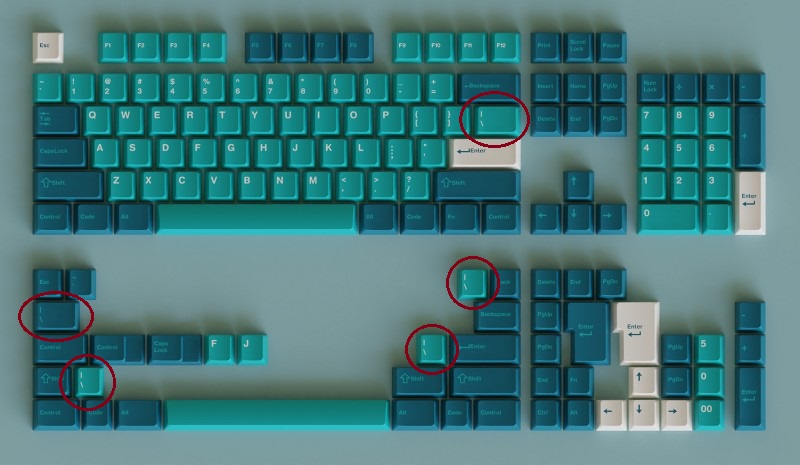
GMK Shark Bait: five keycaps on four rows.
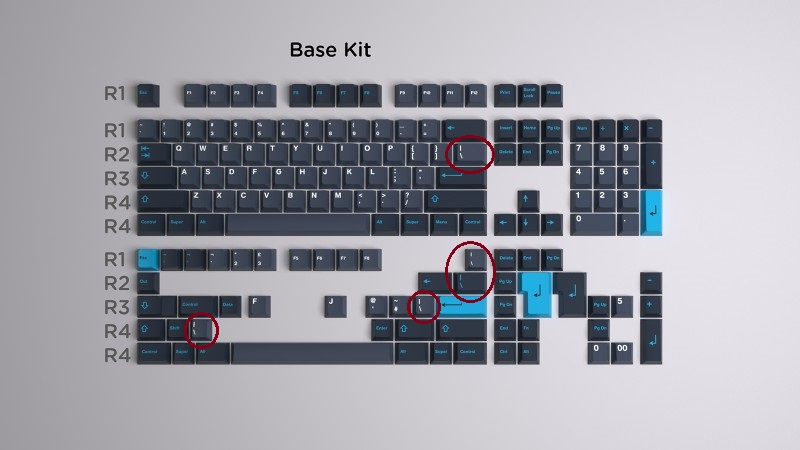
GMK Umbra: five keycaps on four rows.
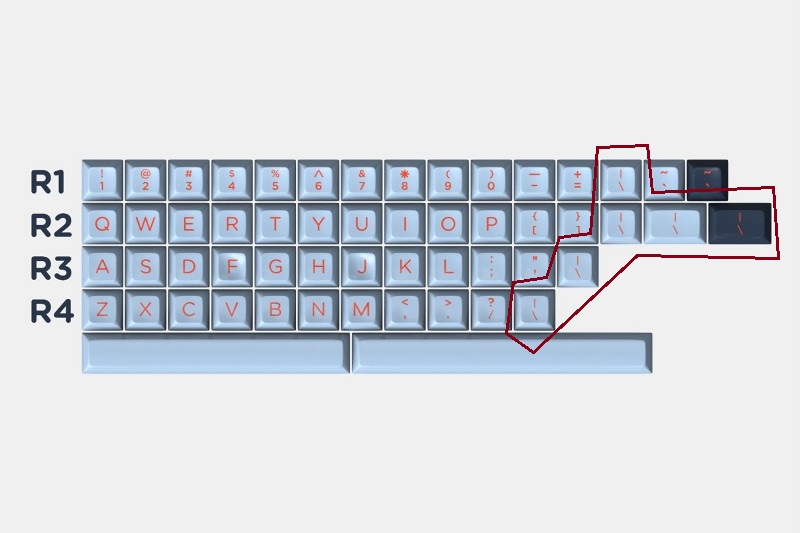
SA Yuri: six keycaps on four rows.
What is going on?
Each of these sets has several backslash‑pipe keycaps, to serve the differing needs of different physical layouts and, if applicable, its own aesthetic considerations. Not all sets serve the same needs, though! What follows is an explanation for each row’s copy or copies of this keycap.
This is the basic alphanumeric block of a normal keyboard with an English (USA) national layout laid on top. In row 2, between the Backspace and horizontal (“ANSI”) Enter keys, there is a backslash‑pipe key, 1.5U in size.

Almost all keycap sets are designed with the primary goal of covering an English (USA) national layout over a physical alphanumeric block with an ANSI layout (this besides other differences the covered form factors or physical layouts may have elsewhere, like the presence of a numeric keypad or the placement of the navigation keys), and thus, there will almost always be a 1.5U row 2 backslash‑pipe keycap present.
Some keycap sets have just one color for all the keycaps (in GMK White on Black, for example, all keys are black with a white legend); others have one color combination for alphanumeric keycaps (“alphas”) and another for the modifiers (“mods”) (like DSA Penumbra and GMK Jamón do). Out of aesthetic considerations, most of the keycap sets in the latter group include “mod-colored” versions of the 1.0U row 1 backquote‑tilde (`~) and the 1.5U row 2 backslash‑pipe keycaps.
Keyboards can have a horizontal (“ANSI”) Enter key or a vertical (“ISO”) Enter key instead; although the former is nowadays ubiquitous in the keyboards sold and used within the United States of America, the latter is just as valid for keyboards with the English (USA) layout, and it’s not difficult to find keyboards of this kind, old or new, be them compact, full-size or battlecruisers (and that’s restricting the search to PC keyboards; the vast majority of terminal keyboards used vertical Enter keys, with this being the only actual option in the Dec layout and IBM’s battleship layout, which were by far the two most common terminal keyboard layouts).

When a keyboard has a vertical Enter key instead of a horizontal one, it “pushes” the backslash‑pipe key to the leftmost area it formerly occupied; a keycap set with full support for the English (USA) national layout will provide a 1.0U row 3 backslash‑pipe keycap to cover this.
And yet... keycap sets that do provide a 1.0U row 3 backslash‑pipe keycap used to be uncommon, although fortunately this has changed. The reason for this absence is historical: the first custom keycap sets were designed thinking exclusively (as opposed to primarily) of the English (USA) national layout over an ANSI physical layout; “ISO support” wasn’t added until later, albeit for a different reason (more on this below).
Some compact keyboards use the 1.5U row 2 key as Backspace (this is known as “HHKB-style Backspace”, as was popularized by the HHKB keyboard... even though it actually originated in Sun Microsystems’ keyboards). Due to this, the backslash‑pipe key is moved to row 1 and takes the left half of the area the original Backspace key used to occupy; the right half is typically used by the backquote‑tilde key, which has been displaced from its top left corner position in favor of Esc.

Most keycap sets provide a 1.0U row 1 backslash‑pipe key to cater to HHKB and HHKB-like physical layouts.
It must be noted, though, that moving the backslash‑pipe key to row 1 like that is not an innovation of the HHKB layout, either. Before IBM released the Model M keyboard with the Enhanced Layout, the PC keyboards it sold used the AT layout, which sported the infamous “BAE” Enter key:

That gigantic thing left no room at all for the backslash‑pipe key and forced it up to row 1; to make space for it, the Backspace key was reduced to 1.0U. This tiny Backspace is the true reason BAE was so hated, and what ultimately led IBM to abandon it in favor of both of the current Enter keys in the Enhanced Layout.
Note the absence of the Esc key in the alpha block as well: it was moved to the numeric keypad of the AT layout; this “innovation” was so disastrous that it was quickly backtracked and abandoned.
Given that the tiny Backspace was so (rightly) hated, some companies came up with alternative physical layouts that kept both the BAE Enter and the (proper) 2.0U Backspace key. The two most popular BAE variants in this regard are:

In the “Focus Layout”, the right Shift key is split on its right side, and the backslash‑pipe key is placed in the space made available.

Meanwhile, in the “Monterey layout”, the backslash‑pipe key is moved down all the way to the bottom row. Note how this is incompatible with modern bottom rows, as the space it occupies is taken by the Windows-specific keys.
Do note that the terms “Focus” and “Monterey”, as used to describe these two BAE variants, are recent, and were taken from well-documented units, one of each brand, in the early days of the hobby; in fact, Monterey itself made more “BAE, Focus style” keyboards than “BAE, Monterey style” units, and Focus-made “BAE, Monterey style” keyboards aren’t hard to find, either.
Modern keycap sets (with a very small number of dishonorable exceptions) do not provide a “BAE” Enter keycap at all, and if they do provide a row 4 backslash‑pipe keycap, it’s not for BAE support. Instead, they do it because...
In terms of the physical arrangement of keys within the alphanumeric block of a keyboard with a given form factor (full-size, 1800, TKL, 75%, etcetera), ANSI keyboards have a 2.25U (“long”) left Shift key and a 2.25U horizontal Enter key; ISO keyboards have, instead, a 1.25U (“short”) left Shift plus a 1.0U alphanumeric key to its right, and a 1.25/1.5U vertical Enter key.
The diagram displayed in the row 3 section shows the ANSISO hybrid physical layout (long left Shift and vertical Enter), which is what the specification for the English (USA) layout actually mandates if going with a vertical Enter key. The standard does not specify any character assignment on the extra alphanumeric key an ISO keyboard has (or, for that matter, an ISANSI hybrid). Because of this, there are two main traditions about what to do if said key is actually present: PC style and terminal style.

In the PC style, the extra key between Shift and Z is simply a copy of the row 3 backslash‑pipe key.

In the terminal style, the extra key between Shift and Z is assigned the less than and greater than signs, as was done in terminal keyboards.
Given that these are just traditions, keycap set designers are free to do whatever they prefer in this regard (as long as they provide a 1.0U row 4 alpha-colored key, so the switch underneath won’t be exposed or “naked”). Sets like GMK Oblivion follow the PC style and include a row 4 backslash‑pipe keycap; sets like GMK Nines and GMK Evil Dolch follow the terminal style and include a row 4 less than‑greater than (<>) keycap. Sets with appropriate “ISO support” were a minority at first, but this has changed and now almost all do (with a clear and unequivocal preference for the terminal style).
With the above said, most of the older or old-minded sets that do include a row 4 backslash‑pipe keycap... do it for yet another reason:

There are many sets that, in addition to full support for English (USA) over ANSI, also contain the necessary keycaps to cover English (UK) over ISO as well. This national layout requires a row 4 backslash‑pipe key, and that is why this keycap is included. Many of the sets with “UK ISO support” (a misnomer, as it conflates the national layout and the physical layout as if they were the same thing) fail to include the row 3 backslash‑pipe keycap, so English (USA) with a vertical Enter key can’t be done correctly. Examples of the differing levels of coverage include:
A common vice in sets from a few years ago was to include some but not all of the keycaps required for the English (UK) layout (typically, row 4 backslash‑pipe and row 3 hash‑tilde (#~) were included, or those two plus row 3 apostrophe‑at ('@), while the keycaps in row 1 were omitted), forcing the keyboard to sport a layout that was neither properly English (USA) nor English (UK); SA Honeywell and DSA Penumbra are clear examples of this.
A few sets add yet another row 2 backslash‑pipe keycap, 1.0U in size. This is for the benefit of some keyboard layouts that reduce the total width of their alpha block from 15.0U to 14.5U (shortening the Backspace, backslash‑pipe, Enter and right Shift keys by 0.5U each to this effect).

Shaving half a unit off in this manner isn’t too bad when dealing with horizontal Enter keys, but when a vertical Enter key is involved, the result is hideous:

That thing over there is termed the “anorexic ISO” Enter key, due to its width of 0.75/1.0U (instead of the 1.25/1.5U width of proper ISO Enter keys, or the 1.0/1.25U width of the still acceptable “thin ISO” Enter keys), and it’s more of an abomination than the 1.0U Backspace ever was. Horrifyingly, modern keyboards like this exist! They shouldn’t! The anorexic ISO Enter key is so uncomfortable to use, it’s actually better to switch to a (shortened) ISANSI hybrid keyboard and use the (short) horizontal Enter key, even if using a national layout where moving (the physical key that corresponds to) backslash‑pipe to row 2 is uncomfortable and best avoided in normal conditions; see the Spanish (Spain) layout, which places the Ç letter there, for a painfully obvious example of this phenomenon.
But, hey, at least the row 3 backslash‑pipe key isn’t affected...
As per unaffected row 3 assignments go, the same happens with ultracompact physical keyboards that use a TIE Enter instead of an ANSI or an ISO Enter key:

As mentioned before, most keycap sets start off with coverage for the English (USA) national layout laid on top of an ANSI keyboard, and from that point add support for ISO (whether it is for the English (USA) national layout, for the English (UK) national layout, or both at the same time).
Other sets are designed from the start with a different national layout in mind, and then the same issue has to be dealt with. For example:
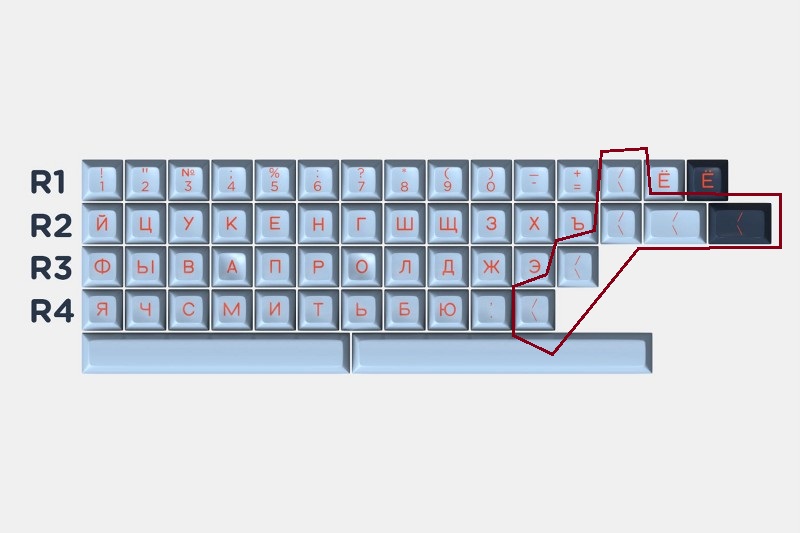
In the Russian national layout, the physical key that produces backslash and pipe in an English (USA) keyboard,
produces instead backslash and slash. Due to this, the Russian alphas keycap set in SA Yuri has six
backslash‑slash keycaps in the same sizes, positions and colors as the corresponding backslash‑pipe
keycaps in the other alphas set.
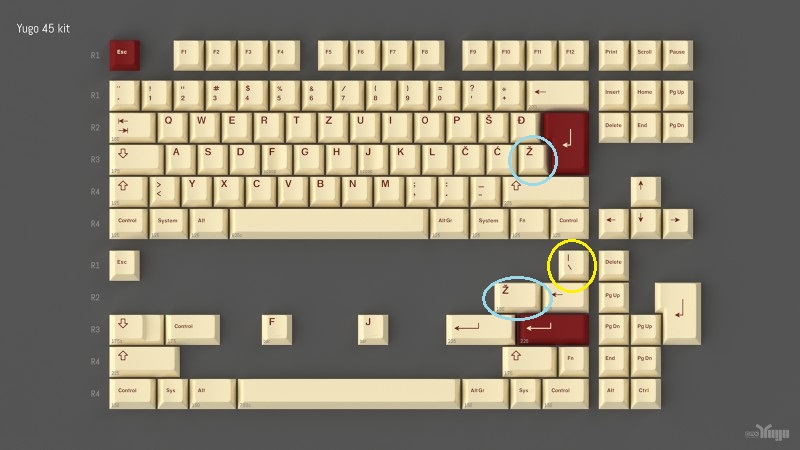
The old Yugoslavian national layout placed the
letter Ž (Z with caron) in the same row 3 physical key that produces backslash
and pipe in an English (USA) keyboard. The GMK Yugo set provides for the usage of a horizontal
Enter by including the 1.5U row 2 version of the same keycap. Note the presence of a row 1
backslash‑pipe keycap, which should have been a Ž as well
instead; this was actually a conscious decision of the design team, though.
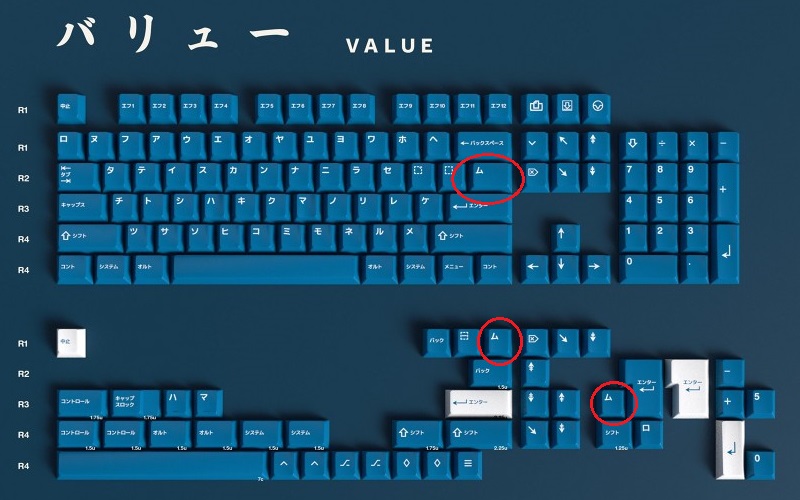
In the Japanese Katakana layout, the physical key that produces backslash and pipe in an English (USA) keyboard,
produces instead the letter Mu (ム). Due to this, the GMK Masterpiece keycap set
provides the necessary three keycaps with this legend, in rows 2 (1.5U), 1 and 3 (both 1.0U).
Last update: 29/10/2022.
Return to Keyboard-related resources.